|
Getting your Trinity Audio player ready...
|
Established 1919
Tucked away in Maine’s islands, this picturesque sanctuary will take your breath away. Acadia National Park features tranquil lakes filled with rocks, imposing granite mountains, lush hardwood forests, and striking seashores–all ready to be explored.
Overview
Nestled on the Maine coast, southwest of Bar Harbor lies Acadia National Park. This national park marks the mid-section of the coastline and safeguards a portion of Mount Desert Island, along with part of Isle au Haut. It also encompasses 16 minor adjacent islands within its boundaries.
Acadia preserves the stunning cliffs, mountains and islands that line the Atlantic coast. This National Park has all kinds of environments, with a vast variety of species living in its clean air and water. The area also boasts a significant cultural heritage.
The park consists of the Atlantic Coast’s highest peak (Cadillac Mountain), exposed granite domes, glacial erratics, U-shaped valleys, and cobble beaches. It also offers diverse vegetation and wildlife. John D. Rockefeller Jr. financially backed a carriage road network that is woven through this landscape. As of 2017, it covers 49,075 acres (76.7 sq mi; 198.6 km2).
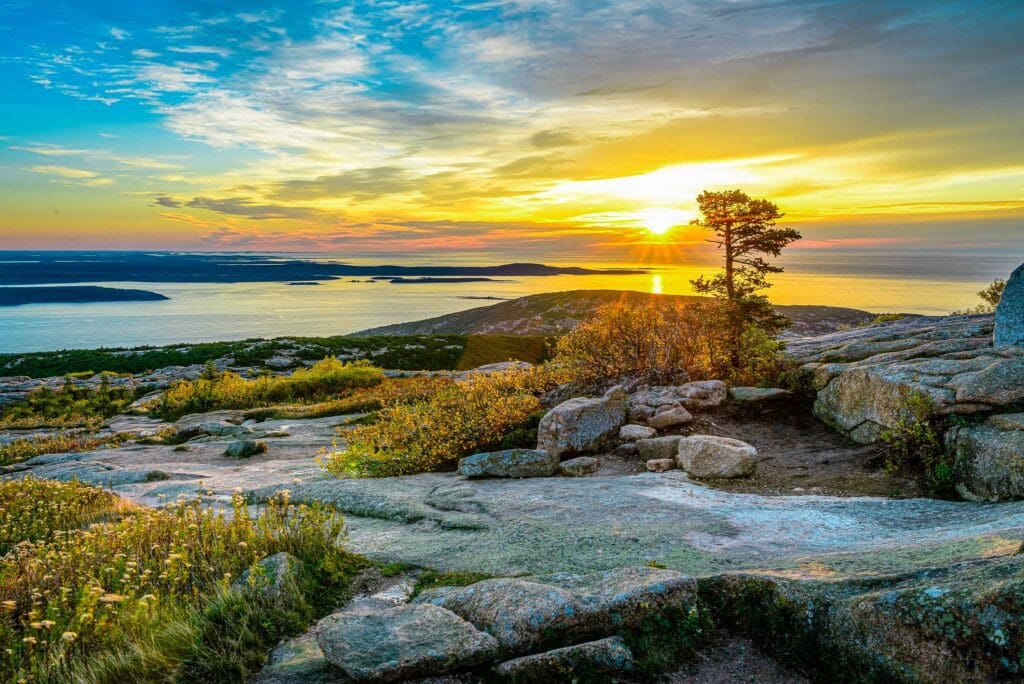
Sunrise at Cadillac Mountain.
For centuries Acadia has been populated by people, starting with the Wabanaki Nation over 10,000 years ago. Later, fur traders and other European explorers settled there in the 17th century, followed by hordes of summer tourists in the 19th. Thanks to George B. Dorr (otherwise known as the “Father of Acadia National Park”) and others who campaigned for it, Acadia was declared a national park—the first east of the Mississippi River and the only one in the Northeastern United States—in 1916 under its first name Sieur de Monts National Monument. It was later renamed and redesignated Lafayette National Park in 1919.
Acadia National Park was renamed in 1929. Throughout spring to fall, visitors can enjoy scenic car or bus tours, hiking and biking on the prohibited motor vehicle trails, fishing, rock climbing, kayaking and canoeing on lakes and ponds, swimming at Sand Beach or Echo Lake, sea kayaking and boat tours, and ranger-led programs. In wintertime, there are available cross-country skiing, snowshoeing, snowmobiling, and ice fishing activities. Campgrounds are located in Mount Desert Island and Schoodic Peninsula while five lean-tosites are found in Isle au Haut. Hulls Cove visitor center is located northwest of Bar Harbor and park visitation has skyrocketed over the past decade with a total record of 4.07 million guests in 2021.
Nestled on Mount Desert Island, Acadia National Park is a paradise for outdoor enthusiasts. With 130 miles of hiking trails, 60 miles of Rockefeller’s Carriage Roads, and sweeping views of the rocky coastline, there are endless activities to enjoy in the park! Swim or kayak in its glacier-carved lakes, bike the expansive car-free paths, and trek through its forests. Then when you’re ready to indulge in civilization, take a trip to Bar Harbor for a taste of the working waterfront, as well as delicious restaurants and stores. In this guide we highlight some of our favorite campgrounds, trails and spots so you can make the most out of your visit to Acadia!
Good to Know: September and October are the best months to plan a trip to Acadia, since the summer tourists will have gone home and the colors of autumn will be in full bloom.
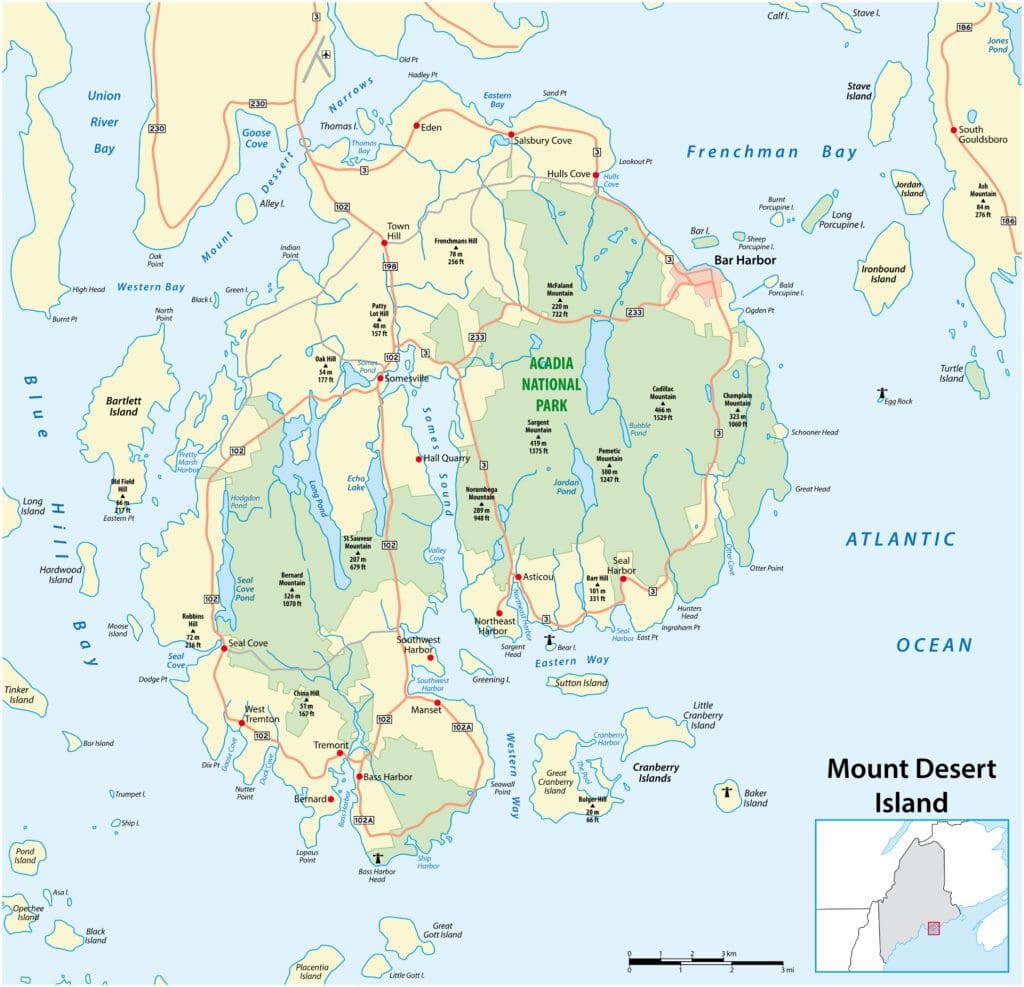
Map of Mount Desert Island, Maine.
Table of Contents:
Article Navigation: Click on any of the listed items in the table of contents below to jump to that section of the article. Similarly, clicking on any large, white section header will jump you back to the Table of Contents.
- Overview
- Human History
- Ecology
- Geology
- Where To Stay
- Enjoying The Park
- Treat Yourself to a Guided Adventure
- Conclusion
Human History
Acadia National Park, situated on Mount Desert Island and surrounding areas in Maine, has a rich human history dating back over 5,000 years. The first inhabitants were the Wabanaki people, who have called this region home for more than 12,000 years. The Wabanaki Confederacy, made up of the Maliseet, Micmac, Passamaquoddy, and Penobscot tribes, has a strong connection to the land that now makes up Acadia National Park. In fact, the name “Pemetic,” meaning “range of mountains,” was given to the area by the Wabanaki people when they guided French explorer Samuel de Champlain during his arrival in 1604.
The arrival of European explorers and colonizers sparked significant transformations in the region. As more people arrived, including French, English, and American settlers after Champlain’s arrival, the first interactions between the Wabanaki and Europeans were documented in the 1600s. Throughout the 17th century, French Jesuit missionaries as well as British and French colonists attempted to establish settlements in the area.
During the 18th and 19th centuries, wealthy individuals known as “rusticators” began constructing lavish mansions and seasonal residences on Mount Desert Island. One notable figure was George Dorr, who became increasingly concerned about the expanding development in Bar Harbor and its potential impact on the island’s natural beauty. He played a crucial role in the conservation movement that ultimately resulted in the creation of the park.
Originally established as Sieur de Monts National Monument in 1916, Acadia National Park was later renamed Lafayette National Park in 1919 and finally became known as Acadia National Park in 1929. The park’s creation was the result of collaboration between wealthy landowners, conservationists, and the federal government to preserve the area’s unique natural beauty. Additionally, John D. Rockefeller Jr.’s efforts in the early 20th century led to the development of a network of carriage roads and trails for visitors to experience the park’s magnificent environment.
Now, Acadia National Park covers over 47,000 acres and is rich in history. It has been shaped by the contributions of various groups, from indigenous peoples to explorers and settlers, as well as conservationists who have helped preserve its cultural and natural heritage. This park is a testament to the diverse and vibrant history of the region.
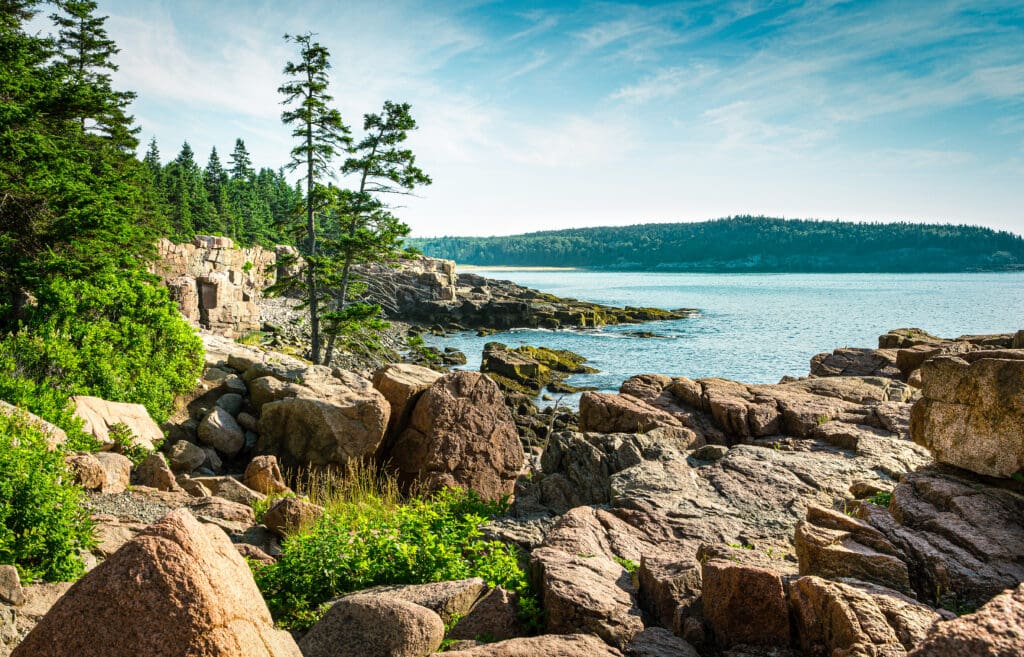
Acadia National Park ‘s Picturesque Shoreline.
Ecology
The ecology of Acadia National Park in Maine is a result of its unique combination of natural features and ecosystems. Situated along the Gulf of Maine and Atlantic flyway, the park lies in a transition zone between temperate deciduous and northern coniferous forests. Its landscape is characterized by glacially carved granite mountains and lakes, surrounded by rocky headlands that showcase various geologic processes at work.
For over 12,000 years, humans have been active in the forests of this park. The Wabanaki people, specifically, have called these forests their home, living in harmony with and relying on its resources since ancient times. Within the park, the Ash tree has special significance in Wabanaki culture and craftsmanship. These forests not only showcase the enduring bond between the Wabanaki people and the land but also reflect the effects of European colonization and modern forestry practices.
The park boasts a wealth of biodiversity, housing an array of plants and animals. The cool mountain climate allows for the growth of spruce and pitch pine in its forests, while subalpine plants thrive in small crevices and sheltered areas. On higher elevations, twisted and dwarfed trees can be found on exposed ridges. Every wetland area is a refuge for at least one uncommon plant species, with over half of the park’s flora being non-native.
The mudflats found in the Downeast Maine coast possess both ecological and economic significance. These unique areas are home to a diverse range of peculiar and alien-like creatures, representing the area’s rich biodiversity. Additionally, they provide a livelihood for the soft-shell clam, lobster and the blood/sandworm industries emphasizing the economic value of these ecosystems.
Overall, the environment of Acadia National Park is a intricate combination of human presence, geological changes, and diverse wildlife. The park’s placement and varying habitats offer a special chance to examine and admire the relationship between natural and human impacts.
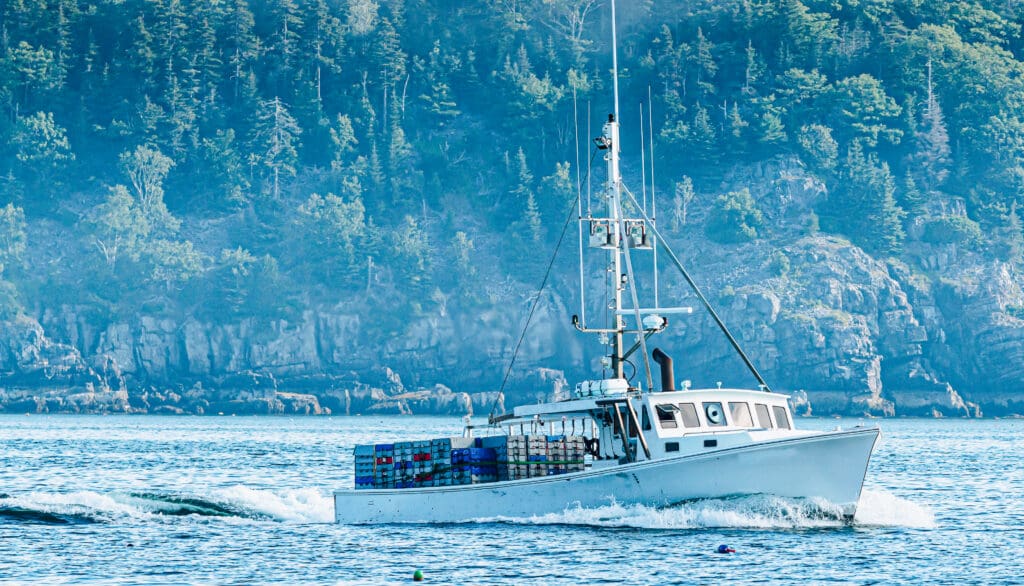
A lobster fishing boat is heading out for a day of work as the fog is lifting with Porcupine Island in the background.
Geology
Situated on the Gulf of Maine and Atlantic flyway, Acadia National Park in Maine boasts a distinctive combination of natural elements and ecosystems due to its position in a transitional area between temperate deciduous and northern coniferous forests. The park’s geology is defined by its presence atop mountains formed by glacial activity and the presence of lake beds shaped by glaciers, all surrounded by rugged cliffs. This landscape perfectly showcases a variety of geological processes at work.
The park’s terrain and land composition have been greatly influenced by glacial events, dating back approximately two to three million years. Massive glaciers rolled across the state of Maine, carving valleys and shaping mountains along their path. This activity reached its peak roughly 18,000 years ago during what is known as the Wisconsin glaciation. As temperatures rose, much of the ice melted and caused isostatic depression, resulting in submergence of certain areas on Mount Desert Island that are now above sea level. In addition to these factors, erosion and tectonic movements have also played a role in creating the unique geology found within the park.
The oldest rocks in the park, known as the Ellsworth Schist, were created around 500 million years ago. They were a combination of sedimentary rocks (mudstone and sandstone) and volcanic ash that underwent a transformation into metamorphic rocks due to extreme heat and pressure. Roughly 420 million years ago, the Cadillac Mountain Granite, one of the largest granite formations in the area, came into being. The convergence of tectonic plates and intense volcanic activity resulted in the deposition of the Bar Harbor Formation and Cranberry Isles Series, two other prominent geological features found within the park.
The park is known for its unique geological features, such as Cadillac Mountain which stands as the highest point on the U.S. Atlantic coast, and Mount Desert Island made of impressive granite formations including the striking shatter zone and diabase dikes.
To sum up, Acadia National Park’s geology is a diverse and complex combination of natural events that have occurred over the course of millions of years. The park’s distinctive mix of geological formations and biological communities makes it a captivating spot for scientists and tourists alike who are fascinated by the dynamic processes shaping our planet.
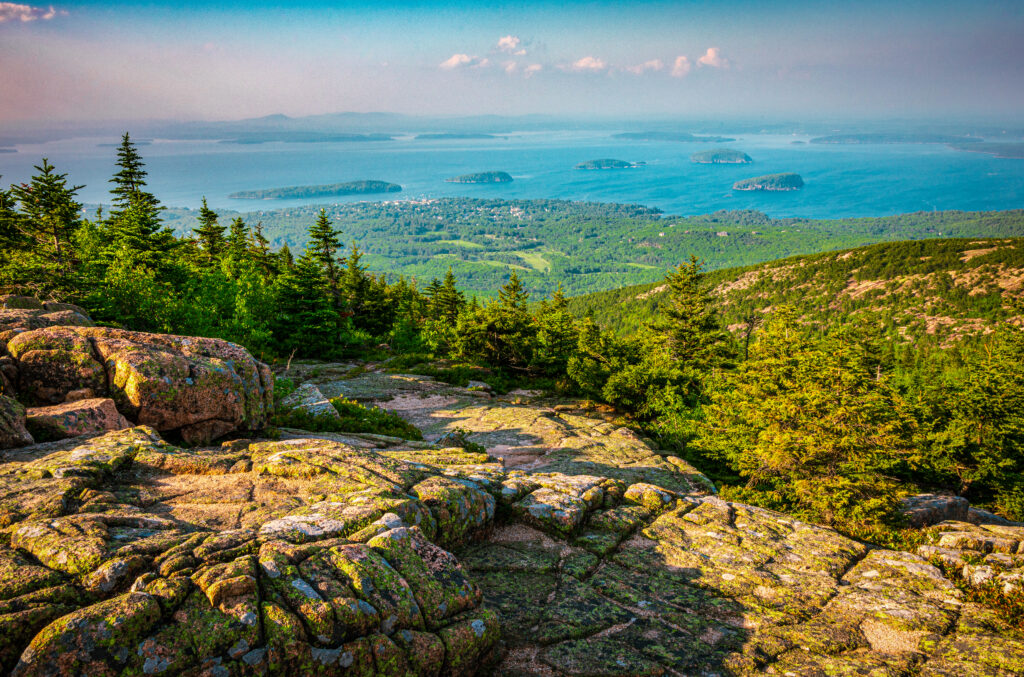
Granite outcrops on Cadillac Mountain in Acadia National Park, Maine.
Where To Stay
Hotels
Certainly! While you can’t stay inside Acadia National Park itself, there are several wonderful options nearby. Here are some of the best places to stay near Acadia National Park:
Nestled in the heart of Bar Harbor, The Inn on Mount Desert boasts a cozy and inviting atmosphere. Perfectly situated near the park, it offers comfortable lodging options for those looking to explore the surrounding area. Additionally, its convenient location puts guests just a stone’s throw from the waterfront, perfect for an evening stroll or morning coffee with a view.
The Bar Harbor Inn and Spa is located on the beautiful waterfront of Bar Harbor, offering breathtaking views of Frenchman Bay. Guests can unwind at the luxurious spa or indulge in delicious meals at the hotel’s restaurant. As a historic establishment, visitors can also appreciate the rich history of the inn during their stay.
Consider staying at The Harborside Hotel, Spa & Marina when visiting Bar Harbor. This hotel offers a marina, spa, and picturesque waterfront views. It’s the perfect location for exploring both the charming town and nearby national park.
At Ullikana Inn, guests can enjoy the quintessential New England charm and romance of a traditional inn. Conveniently located within walking distance of downtown Bar Harbor, it offers a cozy and charming atmosphere for a memorable stay.
Located in the heart of Bar Harbor, the Bar Harbor Grand Hotel offers modern accommodations and easy access to the waterfront and Acadia National Park. Guests can start their day with a complimentary deluxe breakfast before taking a dip in the heated outdoor pool or unwinding in the hot tub.
Located just a short distance from downtown Bar Harbor, The Primrose provides breathtaking views of the nearby mountains and Frenchman Bay. It offers all the comforts and charm of a traditional bed and breakfast experience.
The Bayview Hotel, situated in the charming town of Bar Harbor, boasts cozy rooms and convenient proximity to nearby attractions.
Escape the hustle and bustle of Bar Harbor at the Sand Bar Cottage Inn. Located just outside the town, you can still easily access the park while enjoying a more peaceful atmosphere. Soak in stunning views of the Atlantic’s island-studded waters from your room.
Located in the bustling center of Bar Harbor, the Acadia Hotel is ideal for those seeking a lively experience. Guests can easily access the town’s top-rated restaurants, popular bars, and charming shops.
Located only a short car ride away from Acadia’s entrances, you’ll find the Acadia Inn. Its prime location makes it an ideal choice for travelers. Immerse yourself in the traditional New England atmosphere and charm of the surrounding area during your stay.
The Thornhedge Inn, located just a short distance from downtown Bar Harbor, is the ideal destination for those seeking a charming and comfortable bed and breakfast experience.
For those traveling to Acadia on a budget, the Hampton Inn in Bar Harbor is a great choice. With affordable rates and comfortable accommodations, it’s a great option for the frugal traveler.
Keep in mind that you may not be able to stay within the park itself, but these nearby lodging options offer a range of great choices for your ideal vacation!
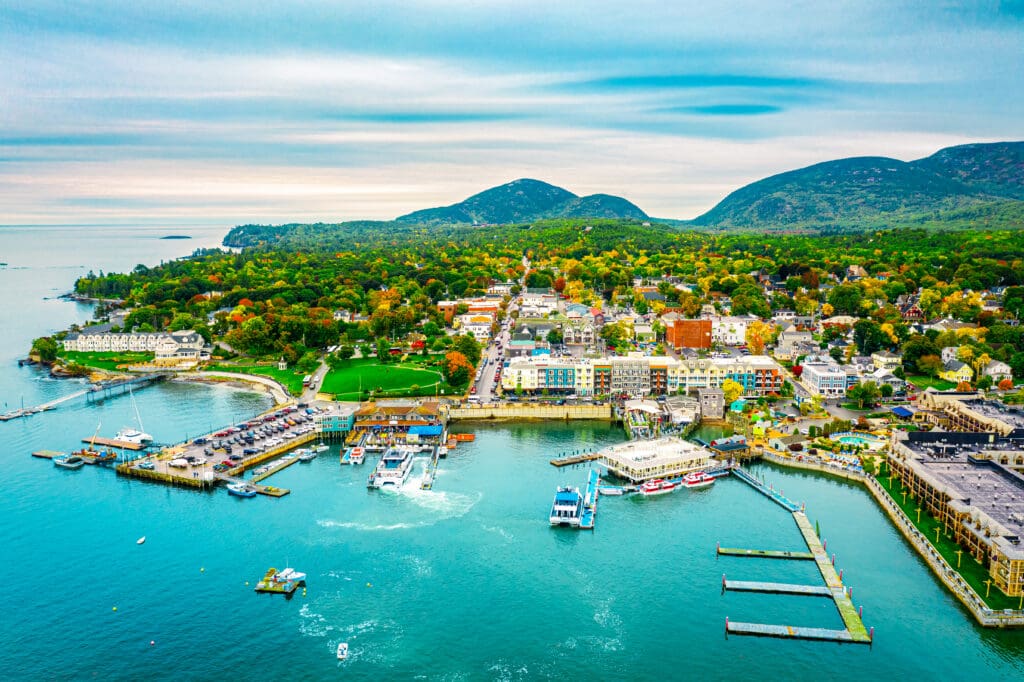
Aerial view of Bar Harbor, Maine. Bar Harbor is a town on Mount Desert Island in Hancock County, Maine and a popular tourist destination.
Camping
Though only two campgrounds, Blackwoods and Seawall, are controlled by the National Park Service (NPS), there are more than a dozen private camping areas close to the park boundaries. This gives visitors easy access to Acadia’s beautiful mountains, lakes, and forests. If the desired dates aren’t available at any of the NPS campsites, then don’t despair! There are still plenty of great options near the trails and coastline that are just a 15 minute drive away.
If you’re looking for camping spots nearby, here are a few of our favorites (each one is within a half-hour radius):
Blackwoods Campground: Blackwoods is the only National Park Service campground located on Acadia’s East Side – this spot makes a great home base for exploring Acadia’s many attractions, such as cruising along the Park Loop Road, climbing Gorham Mountain or The Beehive, or taking a leisurely stroll around Jordan Pond.
The South Ridge of Cadillac Mountain is easy walking distance from the campground, and it provides a gradual slope that leads you to the summit of the tallest peak in the area. While you can’t see the ocean from any particular site, you can hear it when night falls. Facilities such as flush toilets, a dump station, an Islander Explorer Bus Stop, and a nightly ranger-hosted park program at the amphitheater are present. You’ll have to go down the road about a half mile for hot showers; none are available at the campground itself.
In order to reserve one of the Blackwoods campsites, campers need to begin their planning two months in advance. All reservations must be done through recreation.gov before arrival.
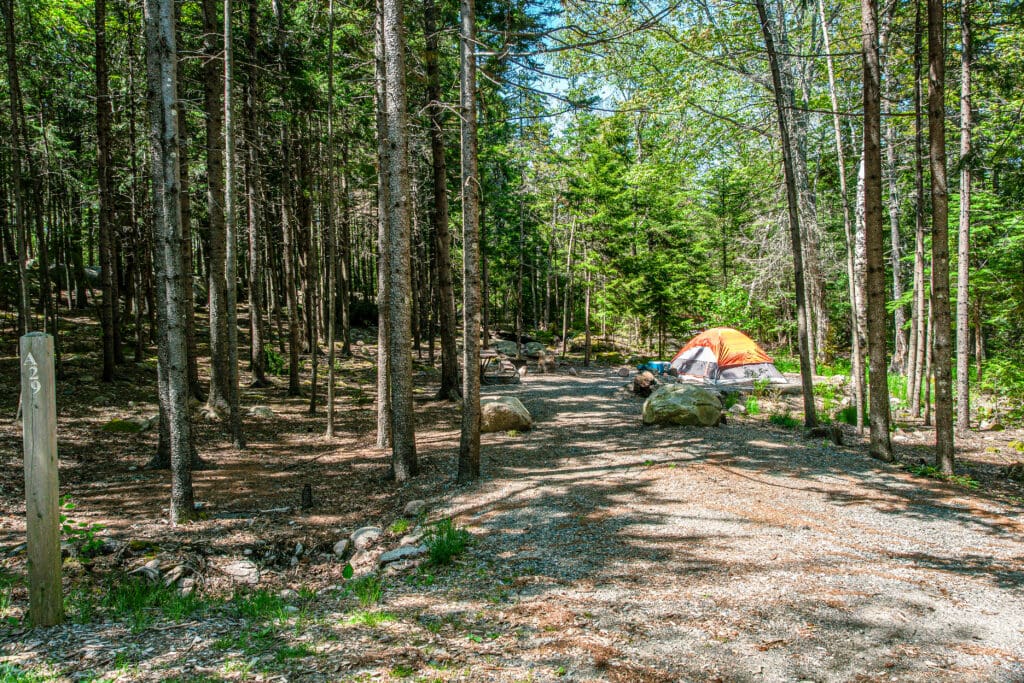
Blackwoods Campground in Acadia National Park.
Seawall Campground: Seawall is the only campground managed by the National Park Service (NPS) on Acadia’s West Side, affectionately nicknamed the “quiet side” due to its lack of tourist activity. It is situated at the southern tip of the island and provides an extremely peaceful atmosphere – all 200 sites are within walking distance of a stunning cobblestone coastal region, and the public picnic area is located directly on the waterfront. Picture yourself barbecuing with seagulls flying above you as the sun dips into the Atlantic Ocean.
Seawall offers basic amenities, such as flushable toilets, a dump station, an Island Explorer Bus Stop, and interpretive ranger-led programming in the evenings. If you need to take a pay shower, there is a camp store around one mile away.
If you plan to camp at Seawall Campground, you should make sure to book your reservation in advance at recreation.gov as they become available two months prior to your planned arrival date. Seawall requires reservations in order to camp there.
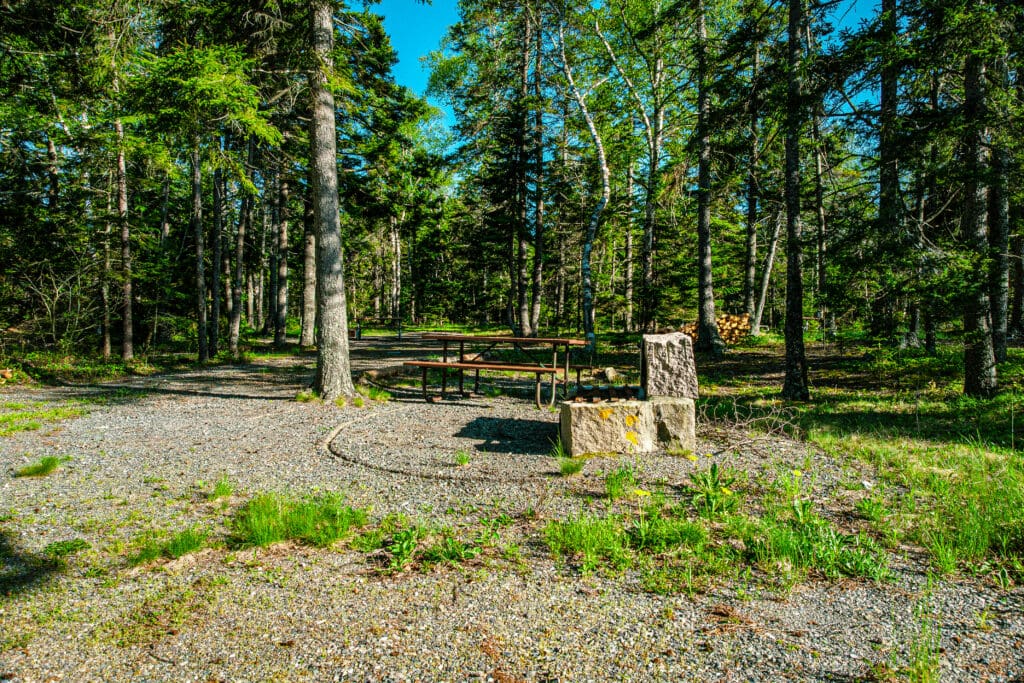
Seawall Campground in Acadia National Park.
Mount Desert Campground: Sitting on the side of Somes Sound in Mount Desert, Maine, the Mount Desert Campground is a family-owned campground situated right in the middle of the island’s eastern and western sides. It’s just five minutes from both Acadia National Park’s bustling East-side and its calmer West-side.
With over 30 stunning sites situated right on the seafront plus a selection that are close by, this campground has everything you could ask for. Enjoy hot showers, kayaks and paddleboards for hire and a store with homemade treats, coffee and ice cream – it doesn’t get much better than this!
In addition, the campground is a regular stop for the free Island Explorer shuttle that operates within Acadia National Park. This is an ideal choice if you want to avoid the difficulty of finding parking at a busy trailhead in the middle of the day. You can book your spot for the season now – don’t miss out!
Oceanside KOA Campground: The Oceanside KOA in Bar Harbor, Maine is situated at the northernmost tip of Mount Desert Island, right after you cross the bridge.
If you are looking for a more traditional campground experience, take a look at the KOA’s oceanfront sites. There are 30 of them, making for an amazing camping set-up! Even if you can’t get one of those prime spots, all of the campsites are close enough to the water that you can almost taste the salt in the air. You’ll also find other amenities available here too; showers, dump stations, laundry facilities, snack bars, playgrounds and a secluded cove for swimming.
Enjoying The Park
The best adventures in Acadia National Park in Maine offer a diverse range of experiences, from breathtaking natural landscapes to thrilling outdoor activities. Here are some highlights:
Watch the Sunrise from Cadillac Mountain
Watching the sunrise from Cadillac Mountain is a truly unforgettable experience. As the highest point along the North Atlantic seaboard, it offers a unique vantage point to witness the first light of the day in the United States for much of the year. The view from the summit is breathtaking, with the sun’s rays illuminating the surrounding ocean and islands in a stunning display of color and light.
To reach the summit for sunrise, you’ll need to plan ahead. During peak season (late May to early October), you’ll need to reserve a vehicle reservation for Cadillac Summit Road. These reservations are in high demand and are available only during certain hours, with sunrise being a popular time. It’s recommended to book well in advance to secure your spot.
The summit can be reached by car or by hiking the Cadillac Summit Loop Trail. The trail is moderately difficult and takes about two hours to complete. If you choose to hike, be sure to bring a flashlight or headlamp, as it will be dark when you start your hike.
Once at the summit, be prepared for the weather. Even in the summer, temperatures can be chilly at the top, and wind can make it feel even colder. Dress in layers and bring a warm coat, hat, and gloves.
Watching the sunrise from Cadillac Mountain is not just about the natural beauty, but also the sense of peace and tranquility that comes from witnessing the dawn of a new day in such a serene setting. It’s an experience that truly captures the spirit of Acadia National Park.
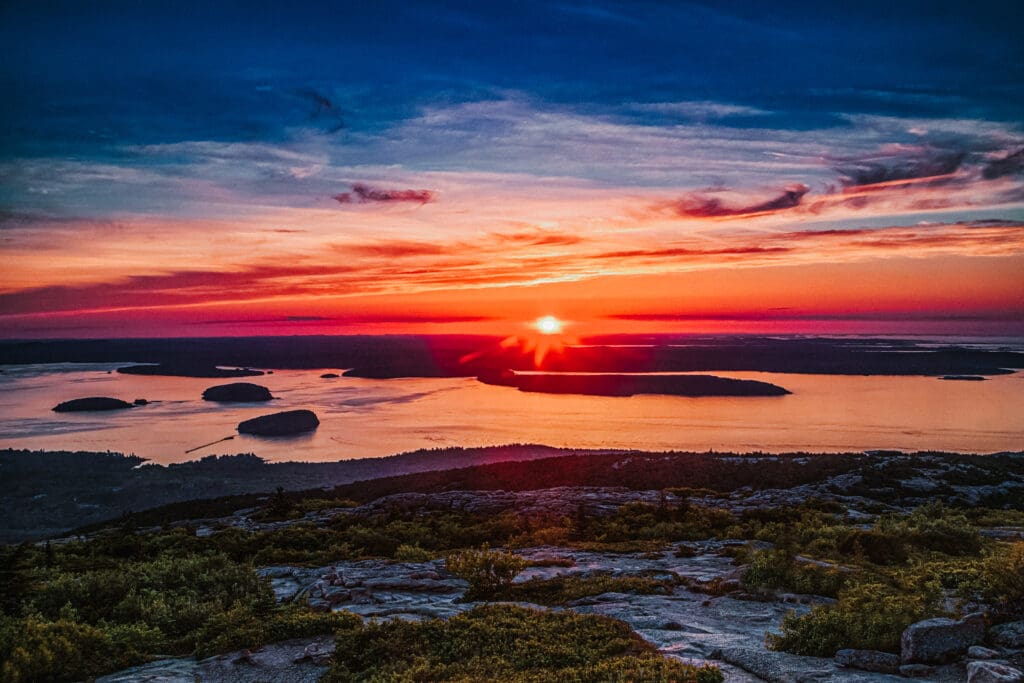
Sun breaking the horizon oveer the Atlantic Ocean viewed from Cadillac Mountain in Acadia National Park
By Andrew S./Adobe Stock.
Hiking Trails
The best hiking trails in Acadia National Park, Maine, as highlighted by AllTrails, include a variety of options for hikers of all skill levels. Here are some of the top trails:
-
Beehive Loop Trail: This is a challenging hike with stunning views of the coast and the Atlantic Ocean. It involves climbing ladders and scrambling, making it a technical hike.
-
Precipice Loop Trail: Another challenging hike that ascends quickly to the summit of Champlain Mountain, offering breathtaking views. This trail is not recommended for those with a fear of heights.
-
Jordan Cliffs Trail: A moderate hike that offers beautiful views of Jordan Pond and the surrounding mountains. It includes sections with iron rungs for added challenge.
-
Ocean Path Trail: An easy trail that follows the coastline from Sand Beach to Otter Point, offering stunning views of the Atlantic Ocean and the rocky coast.
-
Cadillac Mountain South Ridge Trail: A moderate hike that ascends Cadillac Mountain, the highest point in the park. The summit offers panoramic views of the surrounding area.
-
Jordan Pond Path: An easy, family-friendly trail that circles Jordan Pond. It offers beautiful views of the pond and surrounding mountains.
-
Gorham Mountain Trail: A moderate hike that offers views of the coast and the surrounding mountains. It includes sections of exposed granite and some climbing.
-
The Bubbles Trail: A moderate hike that ascends two small mountains, North and South Bubble, offering panoramic views of Jordan Pond and the surrounding area.
-
Beech Mountain Loop Trail: A moderate hike that ascends Beech Mountain, offering views of Long Pond and the surrounding mountains.
Remember to check the latest trail conditions and be prepared for changing weather conditions. Always practice Leave No Trace principles and respect the park’s wildlife and environment.
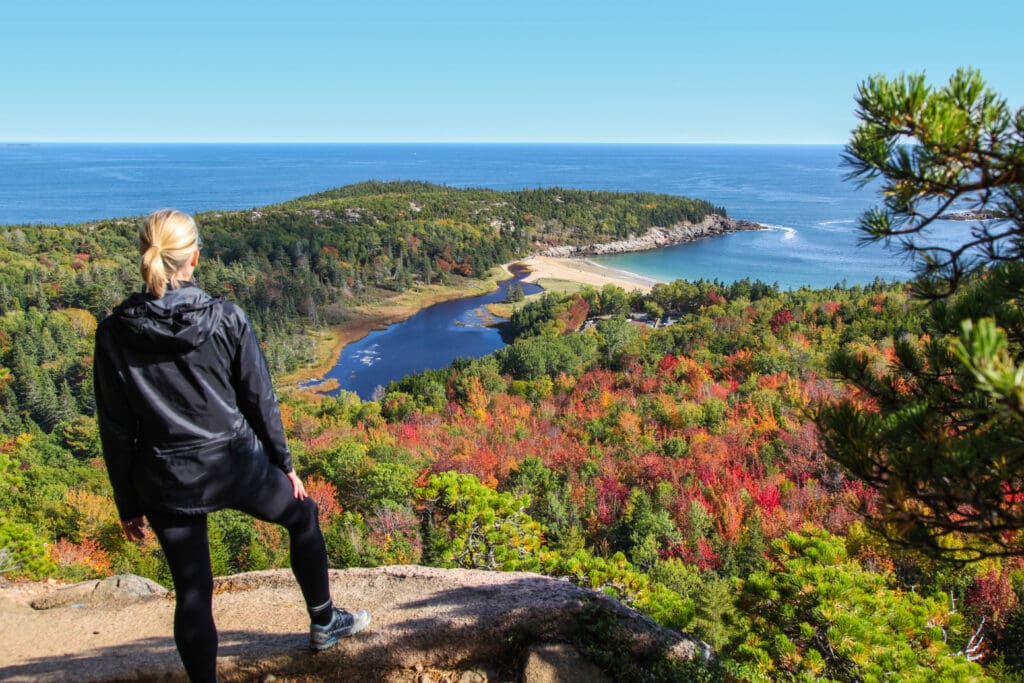
Hiker standing on ledge enjoying view of the Atlantic Ocean from Beehive Loop Trail in Acadia National Park. Photo: Jason Busa/Adobe Stock.
Exploring Park Loop Road
Exploring Park Loop Road in Acadia National Park offers visitors a scenic drive along the eastern side of Mount Desert Island, providing access to the park’s lakes, mountains, and shoreline. The 27-mile (43 km) road is one of three major road systems in the park, constructed between 1921 and 1958, to separate motor vehicle access from local roads and non-motorized carriage roads.
This road is the go-to scenic drive for visitors, connecting to major sights such as Sand Beach, Thunder Hole, and Otter Cliffs on the rugged coastline, and offering the opportunity to drive or hike up to Cadillac Mountain for panoramic views.
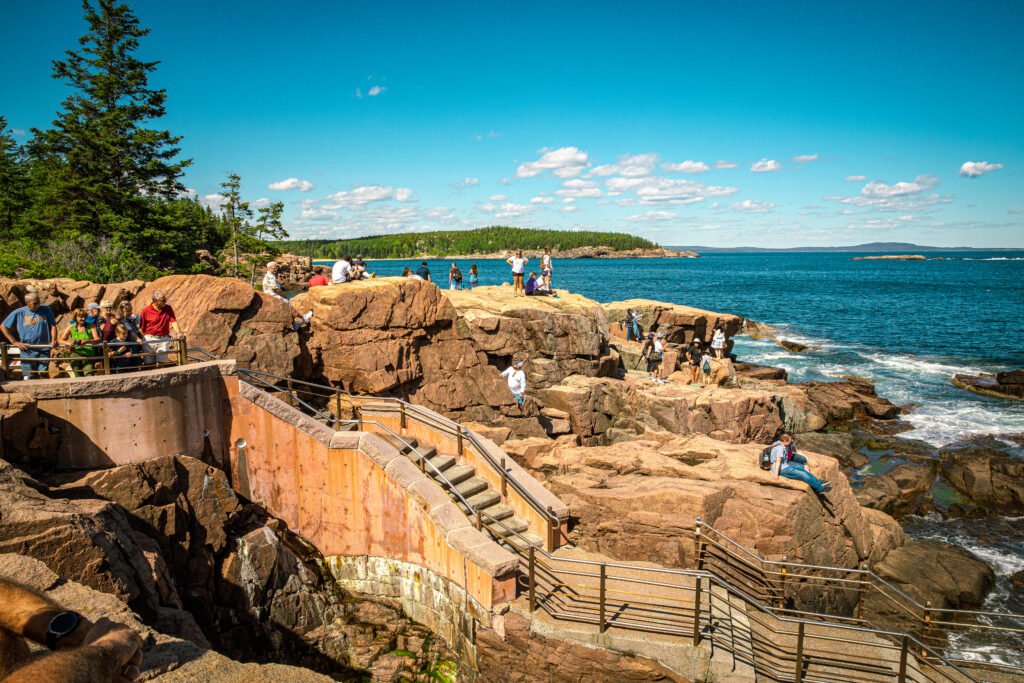
Thunder Hole in Acadia National Park in Maine.
For a comprehensive experience of Acadia National Park, visitors can consider the following stops and activities along the Park Loop Road:
-
Sand Beach – A popular stop for a morning stroll along the shore.
-
Thunder Hole – Known for the unique sounds produced by waves crashing into the rocky shore.
-
Otter Cliffs – Offering stunning views of the coastline and the Atlantic Ocean.
-
Jordan Pond – A beautiful stop for a walk around the pond or to enjoy the famous popovers at the Jordan Pond House.
-
Cadillac Mountain – The highest point along the North Atlantic seaboard, providing spectacular views of the surrounding area.
The Park Loop Road is also a gateway to various hiking trails and points of interest within the park, such as the Precipice Trail, Beehive Trail, and Bubble Rock. Remember to pick up a park entrance pass and check with the park’s visitor center for the latest conditions and any closures.
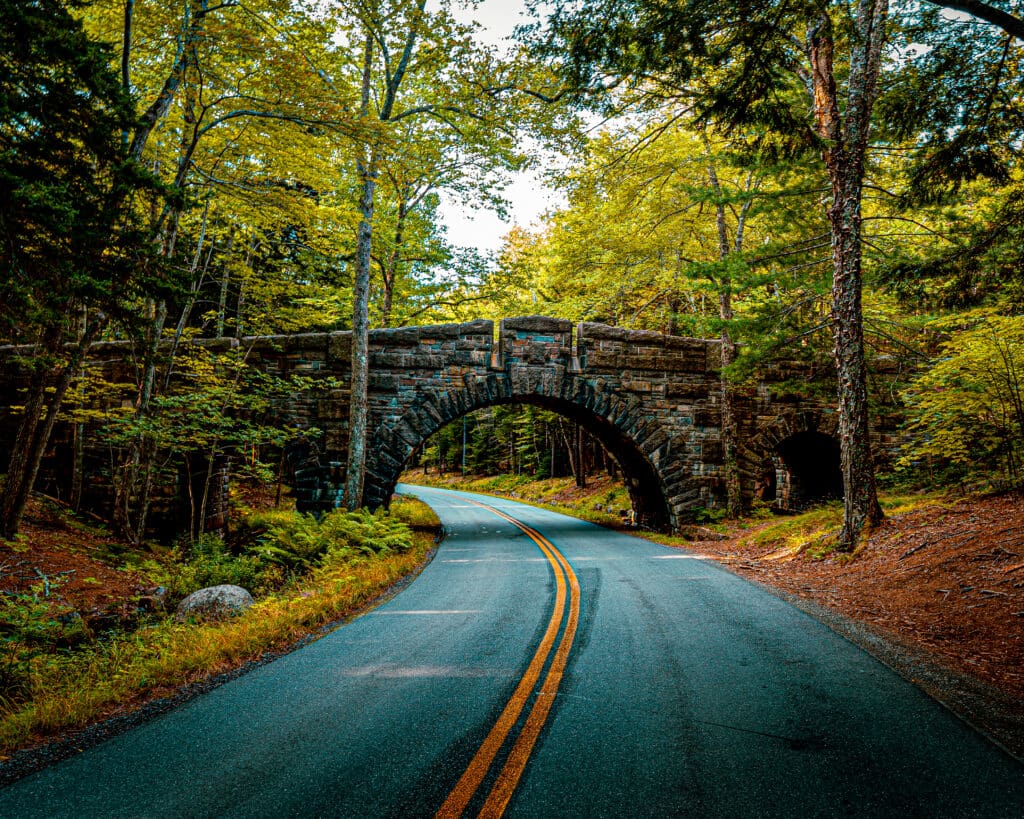
Archway bridge on the Park Loop Road in Acadia National Park. Photo: Nick Vendetta/Adobe Stock.
Carriage Road Biking
Biking on the carriage roads in Acadia National Park is a popular activity for visitors looking to explore the park’s natural beauty away from motor vehicle traffic. The carriage roads, a gift from philanthropist John D. Rockefeller Jr., offer 45 miles of rustic paths winding through the park’s mountains and valleys. These roads are approximately 16 feet wide and were designed to preserve the natural landscape, including saving trees and taking advantage of scenic views.
For those interested in biking on the carriage roads, it’s important to note that only Class 1 E-bikes are permitted. Class 2 and 3 E-bikes, as well as Segways and Hoverboards, are prohibited. The carriage roads are open to pedestrians, bicyclists, and horse-drawn carriages, which means sharing the space and being mindful of other users.
The carriage roads are accessible for biking from April 15 each year, and their maintenance is a priority for the park’s staff and volunteers. There are several suggested bike loops to explore, each offering a unique experience of the park’s diverse landscapes. Some popular routes include the Eagle Lake Loop, Witch Hole Pond Loop, and the Around the Mountain Loop. These routes vary in length and difficulty, providing options for both casual cyclists and more experienced riders.
When planning your biking adventure in Acadia National Park, remember to follow the park’s rules and safety guidelines, including wearing a helmet, carrying water, and being aware of your surroundings. It’s also essential to respect the park’s wildlife and other users of the carriage roads. For more detailed information on biking in Acadia National Park, including suggested routes and safety tips, you can visit the official National Park Service website.
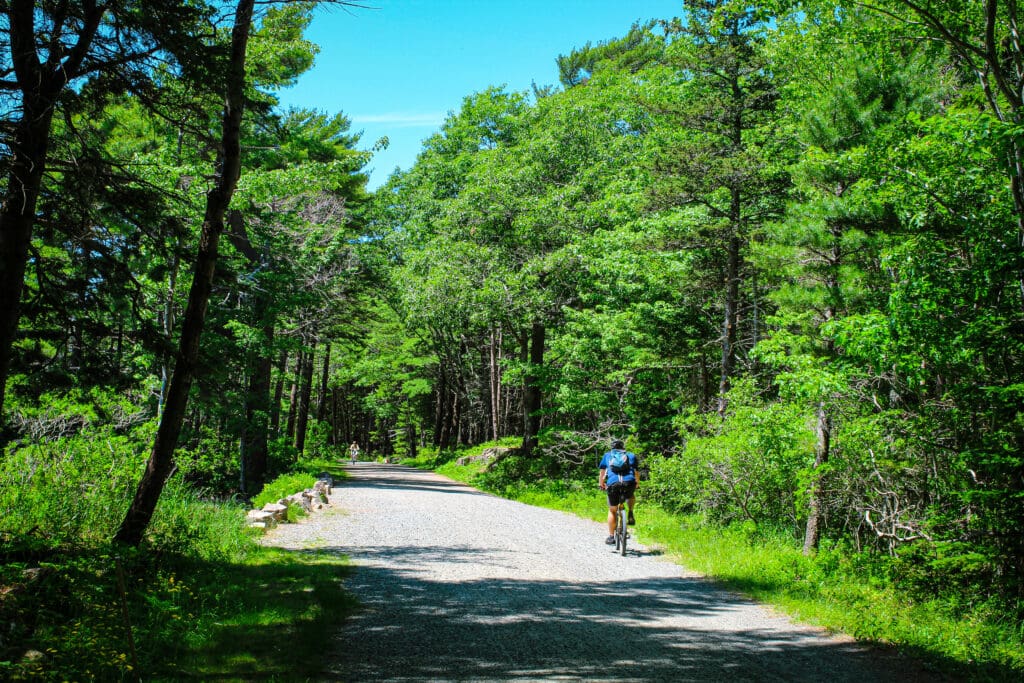
Cyclist on a Carriage Trail at Acadia Naitonal Park.
Ocean Activities
Acadia National Park is a prime destination for ocean activities, boasting breathtaking coastal landscapes and a diverse array of marine life. Here are some top highlights to enjoy during your visit:
Ocean Path Walking Trail: This scenic trail offers an unparalleled walking experience along Mount Desert Island’s eastern shoreline. Trek through rugged terrain with panoramic views of the ocean and quintessential park landmarks like Sand Beach, Thunder Hole, and Otter Cliff.
Tidepooling: Explore the park’s unique tide pools and learn about its diverse marine ecosystems. Low tide is the best time to go tidepooling in Acadia National Park.
Swimming: Visitors can take a dip in both freshwater and ocean locations within the park, but be prepared for cold temperatures even in the summer. One popular spot for swimming is Sand Beach, known for its soft sand and proximity to coastal trails.
Wildlife Watching: The park’s coastal areas are ideal for observing wildlife such as whales, seals, and seabirds. While sightings are not guaranteed, the park’s rich marine life makes it an exciting destination for nature enthusiasts.
Kayaking and Canoeing: For a different perspective on the park’s waters, try kayaking or canoeing in one of its many lakes, like Great Long Pond on Mount Desert Island.
Sea Kayaking
Sea kayaking in Acadia National Park offers a unique and breathtaking experience, allowing you to explore the rugged coastline, diverse wildlife, and serene waters of Maine. The park boasts over 47,000 acres, with most of it located on Mount Desert Island, making it an ideal location for both land and sea adventures. Here are some key points to consider when planning a sea kayaking trip in Acadia:
Guided Tours: Several companies offer guided sea kayaking tours in Acadia National Park, including Acadia Sea Kayaking Adventures, Coastal Kayaking Tours and Maine State Sea Kayak. These tours provide an intimate look at the coastal waters of Mount Desert Island and the park, with a focus on safety, wildlife encounters, and unique natural attractions.
Equipment and Rentals: Companies like Scotty’s Kayak & Canoe Rental provide kayak and canoe rentals, delivering them to vacation cottages, campgrounds, and hotels. They offer single and double kayaks, as well as canoes for up to 4 people.
Popular Routes: Some popular kayaking routes include exploring the Porcupine Islands in Frenchman Bay, taking a sunset or harbor tour, and paddling along the dramatic coastline to see wildlife like harbor seals, porpoises, bald eagles, and osprey.
Safety and Regulations: Always follow safety guidelines and regulations set by the park and your tour operator. Be aware of weather conditions, tides, and potential hazards like strong currents or sudden changes in weather.
Season and Weather: Kayaking in Acadia National Park is generally open from mid-May through mid-October, with hours varying depending on the season. Be prepared for variable weather conditions and dress accordingly.
Accessibility: Some tours offer adaptive kayaking equipment for people with disabilities, ensuring that everyone can enjoy the experience.
Remember to plan ahead, check the availability of tours, and book in advance to secure your spot.
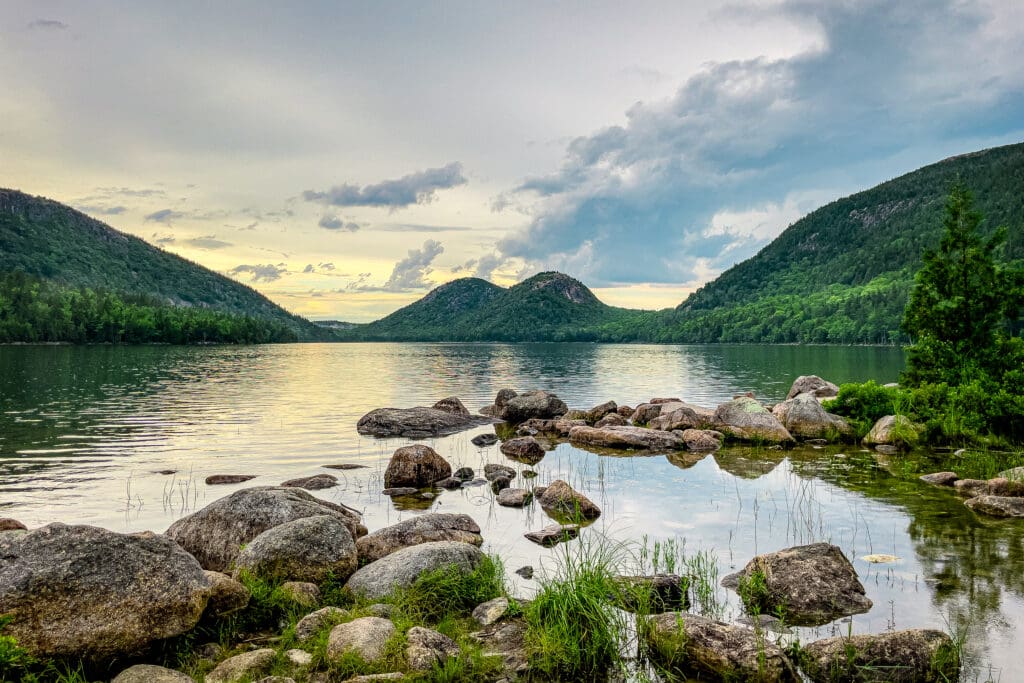
Jordan Pond in Acadia National Park.
Climbing
-
Otter Cliff: Known for its 60-foot sea cliffs, Otter Cliff offers a variety of climbing options including crack and face climbing. Access to the cliff requires rappelling down, and the routes vary up to 5.12 in difficulty. Remember, permits are required for organized groups of more than 5 people.
-
The Precipice (Center, Left, Right, and Lower walls): This area is popular for its multi-pitch routes that can reach up to 5.12 in difficulty. Climbers can expect good corners and thin cracks, along with some beginner-friendly routes.
-
South Bubble: This area is ideal for those looking for 1-3 pitch routes, including some friction climbing. It also offers good beginner routes.
Winter Activities
-
Cross-Country Skiing and Snowshoeing: Acadia National Park has 45 miles (72 km) of carriage roads that are groomed for cross-country skiing and snowshoeing when conditions allow. This is a great way to explore the park’s scenic beauty while getting some exercise.
-
Ice Climbing: The park’s dramatic cliffs and rock outcroppings are covered in ice during the winter, making them perfect for ice climbing. This is an activity for experienced climbers with proper equipment and training.
-
Snowmobiling: Snowmobiles are allowed on certain sections of the Park Loop Road and on the 27 miles of fire roads in the park. This is a fun way to explore the park’s winter landscape.
-
Hiking: While some trails may be closed due to ice and snow, many of the park’s trails are still open in the winter. Be sure to wear proper footwear with traction devices to avoid slipping on icy trails.
-
Wildlife Watching: Winter is a great time to see wildlife in the park. You might spot white-tailed deer, red squirrels, snowshoe hares, and various bird species.
-
Scenic Drives: While parts of the Park Loop Road are closed in the winter, sections in the vicinity of Jordan Pond and along Ocean Drive remain open, offering stunning views of the park’s winter landscape.
- Ice Fishing: Ice fishing is a popular activity in Acadia when weather conditions permit. Freshwater fishing requires a state license, which can be obtained at town offices, local businesses, and online at www.maine.gov/ifw/.
Remember to check the park’s current conditions and closures before your visit, and always be prepared for the cold weather with warm clothing, traction devices for your shoes, and safety gear if engaging in activities like ice climbing or snowmobiling.
Treat Yourself To A Guided Adventure
If you’re looking to explore a new activity or deepen your mastery of an existing sport, it pays to invest in a professional. Guides not only ensure your safety when doing something for the first time, but they can also lead you off the beaten path and offer enlightening details about history, culture and geology. Plus, prepare yourself for captivating narratives no one else can tell. To hire an experienced local pro, you can use services such as 57Hours.
Guided Hiking and Glamping in Acadia National Park (From $2,695 / 5 days): Explore Maine’s Acadia National Park for 150 miles of diverse hiking trails, from coastal strolls to challenging climbs. Experience all four seasons in just a few hours as you journey through woodlands and up to sea-spritzed peaks. A top-tier destination for unforgettable hikes.
Rock Climbing in Acadia National Park (From $185 / 1 day): Acadia National Park in Maine offers diverse climbing terrain, with traditional routes, sport climbs, and bouldering options. The granite cliffs provide ocean views and challenging technical climbs. Popular sites include Precipice, North Bubble, and Canada Cliff. Beginners can try Great Chimney (5.5), while experts can tackle South Wall or hire a guide for a full day experience.
Conclusion
Acadia National Park is a natural wonder in Maine, celebrated for its rocky headlands along the Atlantic coastline, diverse habitats, and rich cultural heritage. It’s one of the most visited parks in the U.S., attracting 4 million visitors annually.
The park boasts 27 miles of historic motor roads, 158 miles of hiking trails, and 45 miles of carriage roads, offering a variety of recreational activities.
Situated mostly on Mount Desert Island, the park also includes portions of smaller islands and the mainland. It’s renowned for Cadillac Mountain, the first place in the U.S. to see the sunrise, and features unique natural attractions like Jordan Pond and Thunder Hole.
Popular Articles:
Adventurer’s Guide to Channel Islands National Park, California
State Bicycle Co. Releases NPF Foundation Bar Bags
Epic Trips: Hiking and Sailing Adventure in the Mythical Faroe Islands
The Dyrt: The 10 Best Campgrounds In Colorado
State Bicycle Co. Pays Tribute to the Legendary Wu-Tang Clan
Terms of Use: As with each guide published on SKYBLUEOVERLAND.com, should you choose to this route, do so at your own risk. Prior to setting out check current local weather, conditions, and land/road closures. While taking a trail, obey all public and private land use restrictions and rules, carry proper safety and navigational equipment, and of course, follow the #leavenotrace guidelines. The information found herein is simply a planning resource to be used as a point of inspiration in conjunction with your own due-diligence. In spite of the fact that this route, associated GPS track (GPX and maps), and all route guidelines were prepared under diligent research by the specified contributor and/or contributors, the accuracy of such and judgement of the author is not guaranteed. SKYBLUE OVERLAND LLC, its partners, associates, and contributors are in no way liable for personal injury, damage to personal property, or any other such situation that might happen to individuals following this route.










